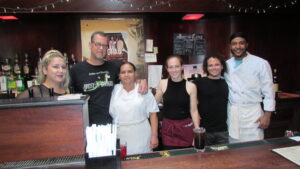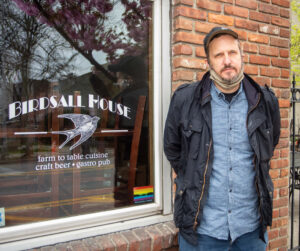
Covid-19 has rocked the world in many profound ways. Millions of Americans were sickened by the disease, hundreds of thousands died. Personal lives and businesses were turned upside down overnight.
The impact on employers and employees plays out every day as work from home becomes ingrained and shortages of labor impact the way companies serve their customers.
Numbers from the state Labor Department paint the picture of how many jobs disappeared in the wake of the first wave last year. Total private employment in the Orange/Rockland/Westchester region stood at 631,300 in June 2019, when the economy was booming.
***
Then the Covid-19 pandemic struck. A year later, in June 2020, the employment total fell to 519,400. Over that 12-month period, 112,000 jobs, or approximately 20% of the workforce, were eliminated.
The restaurant industry all across the nation took the brunt of that hit, and local establishments suffered as well.

“In 2019, we had labor — there really wasn’t a shortage,” said John Sharp, owner of Birdsall House on Main Street in Peekskill. “Now it’s next to impossible. I never closed down Birdsall House, so I kept my employees. We did a little bit of money on takeout but we operated at a loss.
“The places that shut down lost their employees and those employees are gone — they’re in the wind,” Sharp said.
***
Full-service restaurants in Orange/Rockland/Westchester employed 24,300 people in June 2019. A year later, that number fell by half, totaling just 12,200, as the pandemic raged. The numbers at food service and drinking places dropped just as dramatically, going from 49,200 down to 28,400.
Now, the restaurant industry has staged a strong recovery. Sharp said Birdsall House is up between 10 percent to 20 percent month over month compared to 2019.
Sharp has his staff of 24 at Birdsall House and is looking to hire more.
However, finding employees remains a challenge for two primary reasons.
“I think there is a movement out of the restaurant industry because so many other industries had job openings and some people got a job there with benefits,” Sharp said.
***
“There’s also a lot of people not working because they’re sustained by the government benefits. There’s evidence of it everywhere.
“I’ve had people tell me, ‘Well, I’ll be looking in September,’ or they ask for off-the- books, so they can get their benefits, and when I say, ‘No,’ they’re not interested. I know people who are on a perpetual vacation for the last year because they get a weekly check to do whatever they want.”
Today, momentum continues to build along the path to recovery in the job market. Total private employment in the region in June 2021 was 577,100, an increase of 58,000 above the June 2020 low, but still 55,000 below the June 2019 peak.
Full-service restaurants in Orange/Rockland/Westchester made an even stronger recovery, employing 21,100 in June 2021, nearly 9,000 workers higher than the 2020 low point, and just 3,000 short of the 2019 high mark.
***
The numbers at food service and drinking places recovered just as dramatically, rocketing to 44,200 this past June, only 5,000 lower than the June 2019 peak, and 16,000 higher than the depths of June 2020.
Initial weekly unemployment claims also show the return to work. In New York state, peak claims reached 394,701 the week of April 11, 2020. For the week of Aug. 7, 2021 the number was only 14,548, slightly above the same time period in 2019 prior to the pandemic.
Employers will have to compete for workers until the supply meets the demand. Nearly two-thirds of U.S. companies (62%) are willing to increase their base salaries to attract new and salaried employees within the next six months, according to Salary.com.
The report found 82% of employers perceiving a current shortage in employee talent. For job hunters, that has resulted in a marked increase in their wages; 67% of workers surveyed said their starting base salaries were above their market reference point.
***
Replenishing the workforce by restaurants and the looming end of extended unemployment benefits could help turn around the balance between supply and demand of workers.
“It will be interesting to see what happens in September,” Sharp said. “There are now millions of job openings, so maybe it’s time to get rid of the extra benefits and people need to go back to work.
“People who are smart went back to work because they got better pay, way better than the guys who come back later. I won’t drop those higher wages — good for them. They’re the smart guys who came when I needed them.”
***
Sharp also operates Gleason’s in Peekskill and co-owns Factoria at Charles Point with Louis Lanza in Peekskill. River Outpost there is at full capacity and breaking records, but they haven’t re-opened Fin & Brew yet for general dining, although the venue does a lot of business in wedding receptions and special events.
The shortage of specialized workers is an ongoing issue on the road to full recovery. “Fin & Brew is high-end dining, and I can’t just throw anyone in there,” Sharp said.
Some evidence of an economic slowdown due to the Delta variant has appeared, particularly in the south and southeast U.S. So far, the impact isn’t being seen in Westchester, but it could cause some caution. “I am concerned we might have to go back to masking,” Sharp said.
Jim Roberts is a freelance business reporter based in Peekskill.







